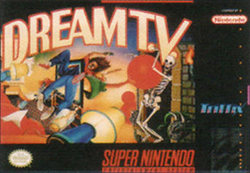Software:Dream TV (video game)
| Dream TV | |
|---|---|
 Cover art | |
| Developer(s) | BITS |
| Publisher(s) | Triffix |
| Designer(s) | Paul Hellier[1] Alex Martin[1] |
| Composer(s) | David Whittaker[2] |
| Platform(s) | Super NES |
| Release | |
| Genre(s) | Action |
| Mode(s) | Single-player Co-op |
Dream TV is an action video game for the Super NES where the player has to guide two youngsters through a nightmarish land of evil television shows (using a similar plot to the campy movie Stay Tuned and Crystal Dynamics' video game Gex). The player has to escape by defeating stereotypical television villains and finding pieces of a puzzle. The game features complex labyrinths.
Gameplay
National video gamers Charlie and Jimmy are given a strange-looking game cartridge game in the mail. When loading it in, the boys find themselves transported into the game.[4] They are sucked in by an evil being known as the Critic.[4] Now Jimmy and Charlie must fight for their lives through four Dream Worlds (Medieval, Egyptian, Prehistoric, and Future) if they hope to return home safely.[4] Dream TV is an action-adventure puzzle video game with elements of ToeJam & Earl (1991), World of Illusion (1992), and The Lost Vikings (1993).[5][6] It incorporates a split screen for both its single-player and two-player modes. Similar to The Lost Vikings, the game involves the player controlling two characters, one of which moves via the L and R buttons.[6][7] Collecting nine hidden puzzle pieces from each level will take the guys to the final showdown with the Critic and hopefully back to reality.[4]
Development
GamePro first announced Dream TV in its October 1992, revealing its premise of kids getting sucked into a television and reporting a planned release of fall 1992.[8]
Reception
| Reception | ||||||||||||
|---|---|---|---|---|---|---|---|---|---|---|---|---|
| ||||||||||||
Reviews from Nintendo Power and VideoGames: The Ultimate Gaming Magazine praised its distinct utilization of the split-screen method, but felt it could've been better.[5][11] Nintendo Power reported situations where two different areas of a level that looked the same time could confuse players, and that a player character could still get hit even if offscreen.[5] The review also criticized the items' lack of clear purpose.[5]
Other critics, although acknowledging the unique split-screen, were not as favorable and felt the experience was worsened by other factors.[7][9] Critics found the character-switch mechanic aggravating to deal with, arguing it was easier to play the game in two-player mode.[9][7][10] Brett Alan Weiss of AllGame noted other several issues, such as the awkward controls, bland items, "poorly drawn and unimaginative" graphics that look like they're from a Master System title, uninteresting-to-fight enemies, and "mind-numbingly repetitive" music.[7] Critics from GameFan criticized its "ugly" and "tiny 8-bit" graphics, and "move to the left, move to the right action that goes nowhere",[9] and the German magazine Video Games called out its "pathetic" sprite animations, music and scarce sound effects.[10]
References
- ↑ 1.0 1.1 "Designer information". MobyGames. http://www.mobygames.com/game/snes/dream-tv.
- ↑ "Composer information". SNESMusic.org. http://www.snesmusic.org/v2/profile.php?profile=set&selected=768.
- ↑ "Release date". GameFAQs. http://www.gamefaqs.com/console/snes/data/588298.html.
- ↑ 4.0 4.1 4.2 4.3 "Basic game summary". IGN. http://cheats.ign.com/objects/011/011842.html.
- ↑ 5.0 5.1 5.2 5.3 5.4 "Now Playing". Nintendo Power 53: 100–105. October 1993. https://archive.org/details/NintendoPowerMagazineTheSNESEra/Nintendo%20Power%20053%20%28Oct%201993%29%20Super%20Star%20Wars%20-%20The%20Empire%20Strikes%20Back/page/n101/mode/2up. Retrieved September 16, 2021.
- ↑ 6.0 6.1 "Dream TV". Video Games & Computer Entertainment (58): 51. November 1993. https://archive.org/details/video-games-the-ultimate-gaming-magazine-issue-58/page/n49/mode/2up?q=%22dream+tv%22. Retrieved 16 September 2021.
- ↑ 7.0 7.1 7.2 7.3 7.4 Weiss, Brett Alan. "Dream T.V. – Review". Archived from the original on November 16, 2014. https://web.archive.org/web/20141116142924/http://www.allgame.com/game.php?id=12326&tab=review. Retrieved September 16, 2021.
- ↑ "Dream TV (SNES)". GamePro (39): 26. October 1992. https://archive.org/details/GamePro_Issue_039_October_1992/page/n27/mode/2up?q=dream+tv. Retrieved 16 September 2021.
- ↑ 9.0 9.1 9.2 9.3 Skid; Sgt. Gamer; K. Lee; The Enquirer (November 1993). "Viewpoint". GameFan 1 (11): 10–11. https://archive.org/details/Gamefan_Vol_1_Issue_11/page/n9/mode/2up?q=%22Awesome+Possum%22+tengen. Retrieved September 16, 2021.
- ↑ 10.0 10.1 10.2 "Dream TV" (in de). Video Games: 101. August 1994. https://www.kultboy.com/index.php?site=t&id=19432. Retrieved September 16, 2021.
- ↑ 11.0 11.1 "Dream TV". VideoGames: The Ultimate Gaming Magazine (61): 87. February 1994. https://archive.org/details/Video_Games_The_Ultimate_Gaming_Magazine_Issue_61_February_1994/page/n89/mode/2up?q=dream+tv. Retrieved September 16, 2021.
 |

